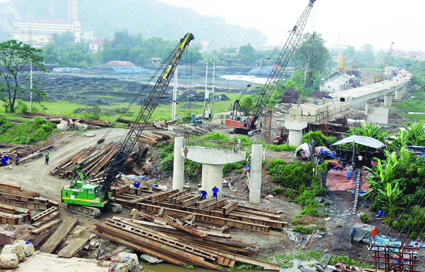Taking effective on January 1 this year, the Public Investment Law (the Law) aims to improve the effectiveness of public investment management in line with international practices.
Consisting of six chapters with 108 articles, the Law governs the management and use of public investment funds and state management of public investment. It also defines rights, obligations and responsibilities of agencies, units, organizations and individuals related to public investment activities.
According to the Law, public investment includes investment in socio-economic infrastructure programs and projects; investment serving activities of state agencies, non-business units, political organizations and socio-political organizations; investment in and support of the provision of public products and services; and state investment in public-private partnership projects.
 |
Nhat Tan bridge in Hanoi __Photo: Huy Hung/VNA |
The Law encourages organizations and individuals to make direct investment or investment in the form of public-private partnership (PPP) for socio-economic infrastructure and public-service provision projects.
Public investment funds include funds from the state budget, funds from national and government bonds and municipal bonds, official development assistance (ODA) loans, concessional loans of foreign donors, state development investment credit, retained revenues for investment not yet included in the state budget balance and other loans borrowed by local budgets for investment purposes.
The Law creates a complete legal framework for the management of the entire public investment process, from investment decision, capital source verification to project implementation, monitoring and evaluation.
Decision on investment policy
To prevent arbitrary approval of investment projects and enhance responsibilities of decision-makers, the Law specifies the process of investment policy decision in Chapter II.
Under the Law, public investment projects may be classified in two ways. Depending on their characteristics, projects are classified into those with construction components or without construction components. Based on their importance and size, projects are classified into national important projects and group-A, group-B and group-C projects according to specific criteria.
The Law makes quite new provisions on competence to decide on conditions, order and procedures for deciding on investment policy with regard to each type of projects or programs. Noticeably, the competence to decide and order for decision on investment policy are very strict.
Programs and projects financed by ODA loans or concessional loans of foreign donors
Under the Law, investment policy will be decided by the Government, for target programs, or by the Prime Minister, for other investment programs and projects as stipulated by the Government. Ministers may decide on investment policy on projects under their management. The order and procedures for decision on investment policy are clearly defined in Article 24.
After obtaining decisions on investment policy, managing agencies will issue decisions on project owners and assign them to work with donors to make feasibility study reports for programs or projects and submit them to competent authorities for decision on investment, the Law states. The order of formulation and appraisal of programs and projects and decision on their investment, must comply with Article 45. The Prime Minister may decide on investment programs and projects in the areas of security, national defense and religion, and other programs and projects according to the Government’s regulations. Ministers may decide on group-A, group-B and group-C investment projects under their management.
The Law also establishes principles of formulation of medium-term and annual investment plans financed by ODA loans and concessional loans of foreign donor. Accordingly, these plans will be developed based on annual implementation plans of programs and projects approved by competent authorities and the schedules committed to foreign donors. These plans must satisfy the requirements specified in Article 70. The formulation, appraisal and approval of investment plans are provided in Article 71.
The duration of disbursement of funds for implementation of medium-term and annual public investment plans must comply with treaties on ODA loans and concessional loans signed with foreign donors. Foreign funds contributed to annual public investment plans may be disbursed according to the foreign donors’ schedules of implementation and allocation of funds.
The Ministry of Planning and Investment will take responsibility before the Government for the uniform state management of foreign ODA loans and concessional loans. The Ministry will act as a focal point for mobilization, coordination, management and use of these loans.
Investment supervision by the community
As required by the Law, programs and projects are subject to community supervision. Vietnam Fatherland Front committees will organize the supervision. The Law also specifies the order, procedures and process of investment supervision.
Community supervision covers the following contents: observance of the laws on investment, construction, land, waste treatment and environmental protection; compensation and ground clearance work and resettlement plans to ensure people’s interests; programs and projects partly funded by residents; the situation and progress of implementation of programs and projects; publicity and transparency in public investment; detection of infringements upon community interests, the project’s negative impacts on the community’s living environment during the project implementation and operation, waste and losses of the project’s funds and assets.
Managing agencies will consult residents in localities where projects are carried out on investment decision regarding national important projects, group-A projects, projects with large-scale relocation and resettlement, projects with high potential impacts on the environment and projects with direct impacts on the socio-economic life of local residents on investment policy, construction, land, waste treatment and environmental protection, compensation, ground clearance and resettlement schemes.
Besides, the Law details the monitoring, examination, evaluation and inspection of public investment plans and prohibited acts in public investment.
Programs and projects that have been decided by competent authorities before the effective date of the Law and have not been allocated funds yet may be carried out as planned, provided they are included in investment plans approved by competent authorities. For those not yet included in any approved investment plans, their formulation, appraisal and investment policy decisions must comply with the Law.
With the above new provisions, the implementation of the Law is expected to help restructure public investment toward higher effectiveness and ensure publicity and transparency in the management and use of the State’s resources.- (VLLF)

